Seeing Things: December 2010 Archives
Mark Morris Dance Group: The Hard Nut / BAM Howard Gilman Opera House, Brooklyn, NY / December 10-19, 2010
For all the rigorously classical attributes of his work, Mark Morris, celebrated for his choreographic chops, has a distinct renegade streak. The Hard Nut, his version of The Nutcracker ballet, gives his iconoclastic outlook every opportunity to flourish. Morris's take on the glorious Tchaikovsky score was created in 1991, when the Mark Morris Dance Group was in luxurious exile in Brussels, as the resident dance company of the Théâtre Royal de La Monnaie. A year later, when it was first performed in the States--where the custom of taking the kids to some version of the Yuletide treat had run rampant--it was seen as an antic response to the undisputed finest of traditional versions: George Balanchine's.
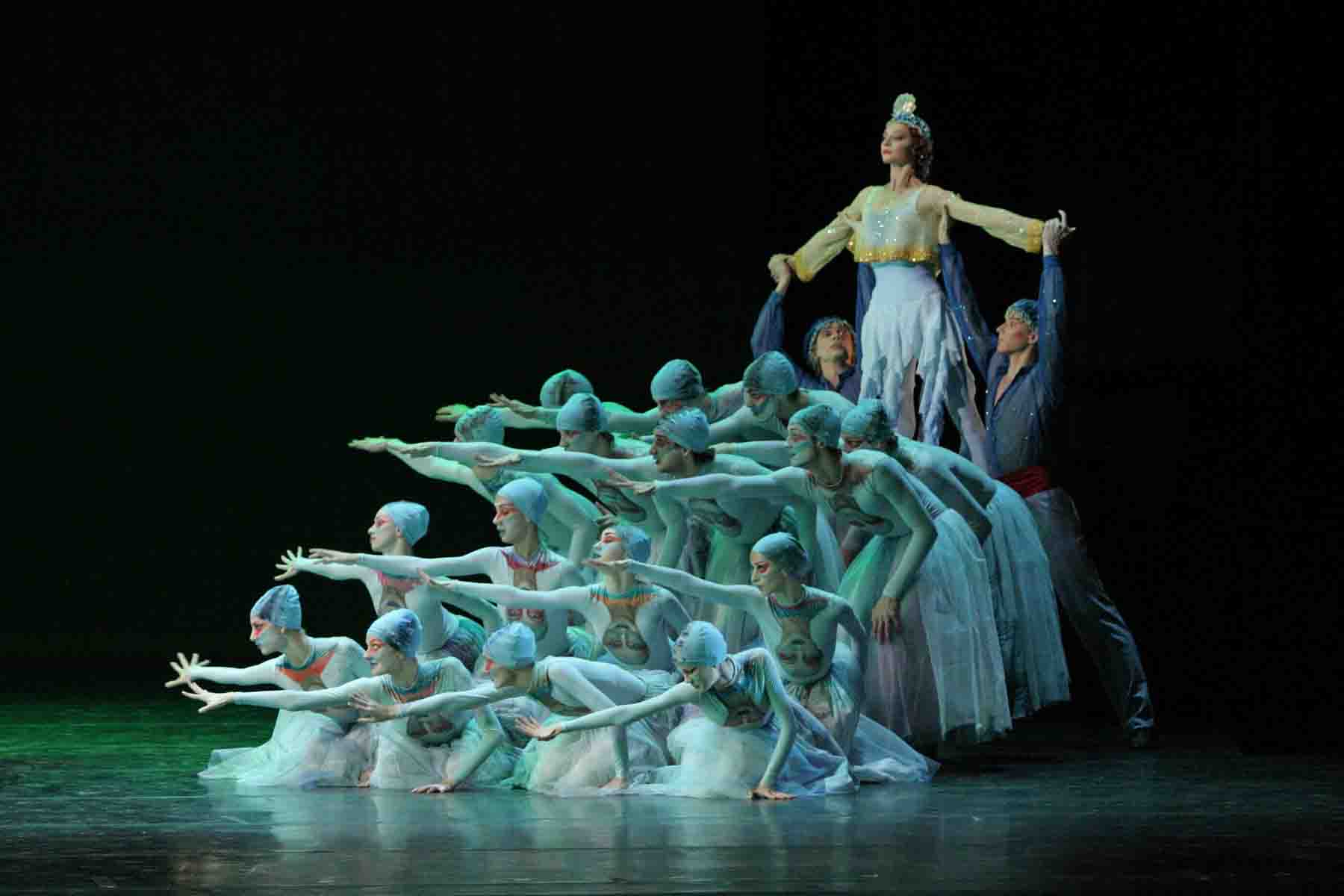
Christmas Eve Combat: Members of the Mark Morris Dance Group in The Hard Nut
Photo: Susana Millman
Time changes everything. Today, both committed ballet fans and folks who see, maybe, one dance performance a year, take The Hard Nut seriously. It's no longer an amusing spoof (many viewers have never seen the ballet it's thought to be spoofing). And it hasn't merely become popular. It's been admitted to the canon of works that have survived the time of their making and are expected to be seen again (and again) in the years to come. Like Matthew Bourne's Swan Lake, the show once considered a send-up has become a classic.
The Hard Nut certainly doesn't stint on anything--except, of course, decorum. It uses the entire score Tchaikovsky composed for the original ballet choreographed for St. Petersburg's Maryinsky Ballet in 1892 by Lev Ivanov (substituting for Marius Petipa who had fallen ill). And it includes the scariest part of the E.T.A. Hoffmann tale, The Nutcracker and the Mouse King, on which the original was based--and which most choreographers steer clear of for fear of marring a seemingly transcendent vision of Christmas joy. It probes further than any other Nutcracker ballet I've seen into the sexual subtext of the story, bringing out the sometimes fraught and always poignant passage from childhood to womanhood of the young heroine (the pre-pubescent Marie) and the enigmatic nature of the attraction the godfather figure (Herr Drosselmeier) has to the girl. (Is he a creator of benign magic for a child he adores or a latent pederast?) It revels in the outré and the absurd and sees youngsters for what they are--sometimes monsters, sometimes angels, most often quite ordinary souls, struggling and dreaming their way toward adulthood.
Morris sets his ballet in the American suburbia of the 1960s and '70s, in the bosom of a family that gives new meaning to the word dysfunctional. Charles Burns, the distinctive comic-book artist who collaborated on the Hard Nut production, designed the adamantly sharp-edged, black and white world in which the ballet takes place. Uncompromising in revealing harsh truths, it's undeniably stylish.
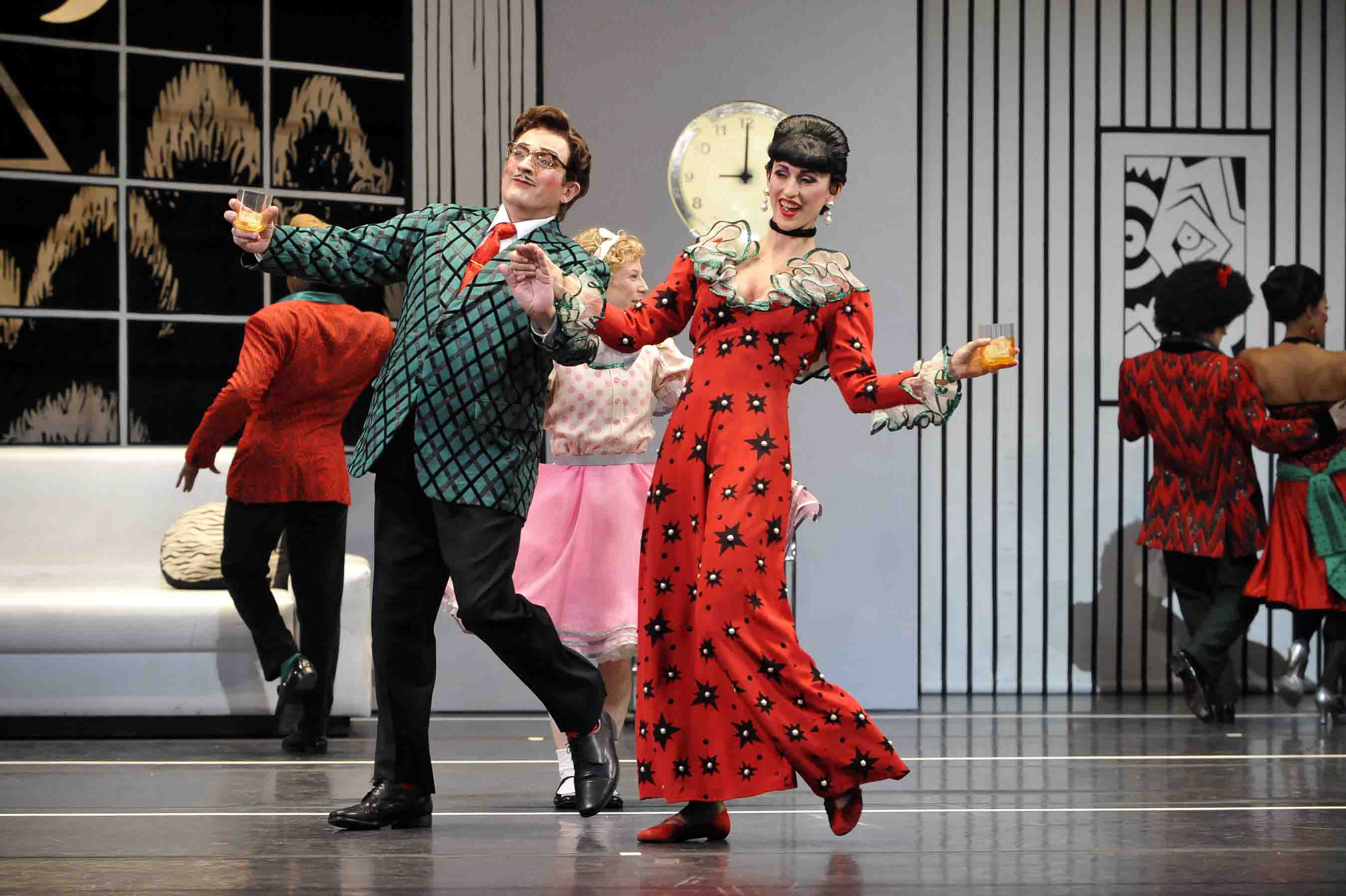
Party Time: Mark Morris and Amber Star Merkins
Photo: Stephanie Berger
The Christmas Eve party that opens the ballet reveals a nuclear family comprising a bumbling dad (now played by Morris himself, with terrific timing); a mom (John Heginbotham) who depends on alcohol and happy pills to sustain her futile aspiration to glamour; our heroine, the young Marie (Lauren Grant), still innocent enough to be dressed in frilly pink; her venomously adolescent older sister (Julie Worden); and her obstreperous brother, Fritz (June Omura).
And then there's the maid (Kraig Patterson), who knows full well she's not "just like family" and regards her employers with cynical resignation that fails to smother her sassiness. Patterson, a rail-thin black man with a ravishing back displayed by the plunging spineline of his/her costume, originated the role and has gotten better and better in it for two decades. His spidery pointe work--his character's main method of navigation--is, alone, worth the price of admission. From the start it's obvious that the casting of this show wasn't hemmed in by gender conventions; rather, it's enhanced by flouting them.
As for the "friends depicted within," they're about as crass and raunchy as can be without actually breaking the law, and right on top of the animal-inspired popular dances of the day.
Let me hustle you through the rest of the Act I plot. Drosselmeier presents Marie with a painted wooden nutcracker, which she adores on the spot. Fritz yanks it away and breaks it. Marie is heartbroken. The party guests leave. The family goes to bed. But Marie, now in her nightie (pink) with bunny slippers to match (trust the costume designer Martin Pakledinaz to get these things right!), re-appears in the living room to cuddle her injured toy. Sudden transformation: everything in the room becomes enormous. A colony of rats--larger and larger rats--appears, terrifying Marie. Nevertheless, she and her Nutcracker, aided by a bevy of G.I. Joes, vanquish the rodent enemies. The seven-headed rat king--every noggin crowned--lies slain, thanks to Marie's alacrity with one of her slippers.
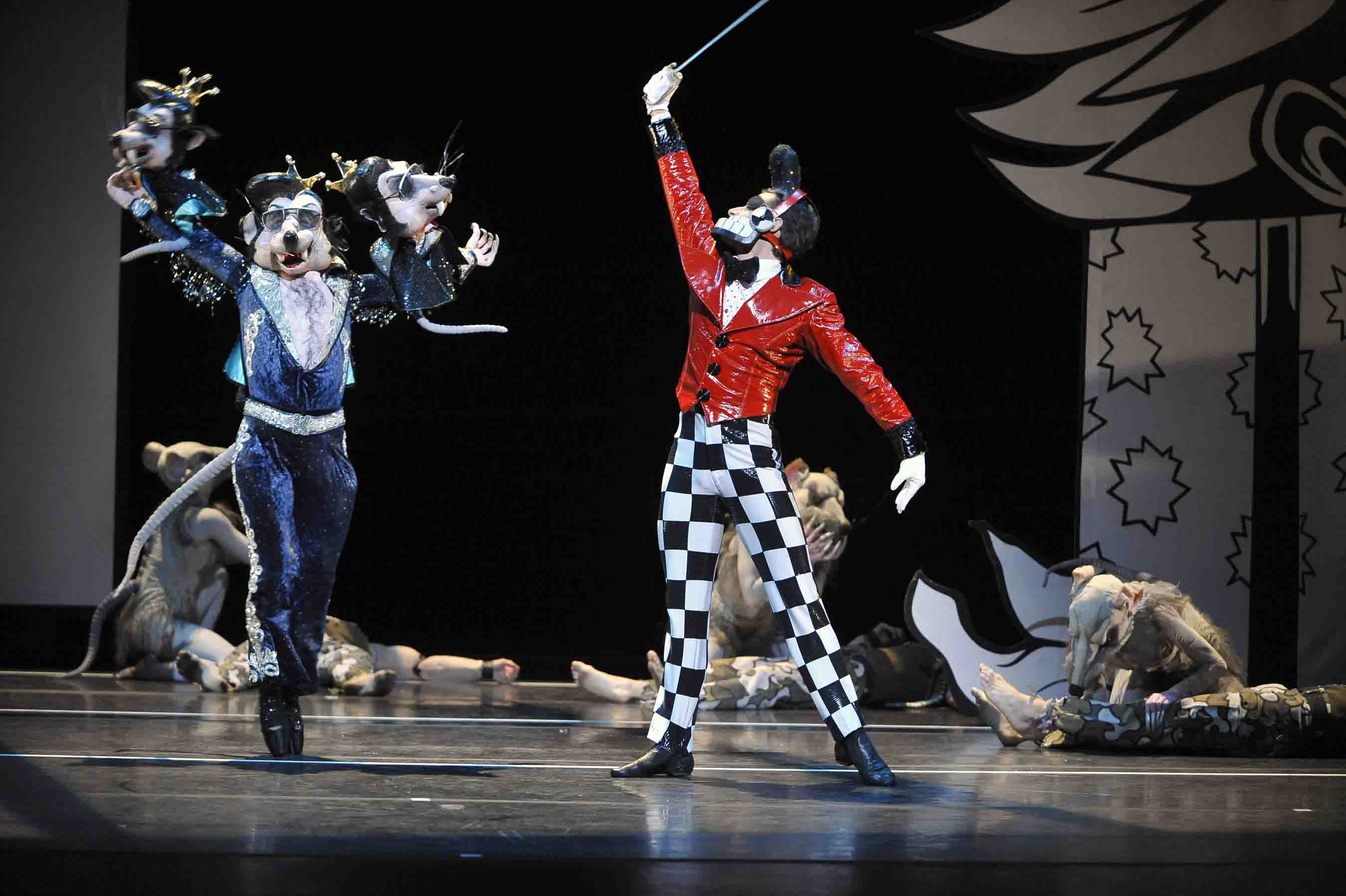
Rodent King vs. Nutcracker Prince: Utafumi Takemura and David Leventhal
Photo: Stephanie Berger
Now the girl lies unconscious--downstage, supine, legs splayed to reveal a crotch covered by pink ruffles--having fainted from her fright and her efforts. Center stage, there's one of the simplest and most eloquent love pas de deux that ballet has to offer--for Drosselmeier and the Nutcracker, who has become human, even princely. (The house program calls him "Young Drosselmeier"; David Leventhal, the most exquisitely classical of the Morris dancers, is perfect in the role.) The love between the two men is partly the feeling of a parent or mentor towards a son, a nephew, or a protégé and partly erotic--though entirely tender, never lustful. It's enormously moving, and acquires its full impact when, at the end of Act II, we see the young man repeat some of the moves he shared with Drosselmeier as he and Marie declare their first timid but increasingly ardent, love to each other.
That's later, though. Just now Marie and her Nutcracker Prince venture into another, illusory, world whose way station is a wintry forest. Here, for the Snow scene, 22 dancers, male and female alike, wear the same costume, executed in a palette of white, black, and silver: bolero tops; short, audaciously bouncy tutus; and, in past performances, with some of the dancers in black pointe shoes and some barefoot. Their heads are sheathed in helmets studded with paillettes that catch the lights and beam out flashes so brief and tiny, you think you might be imagining them.
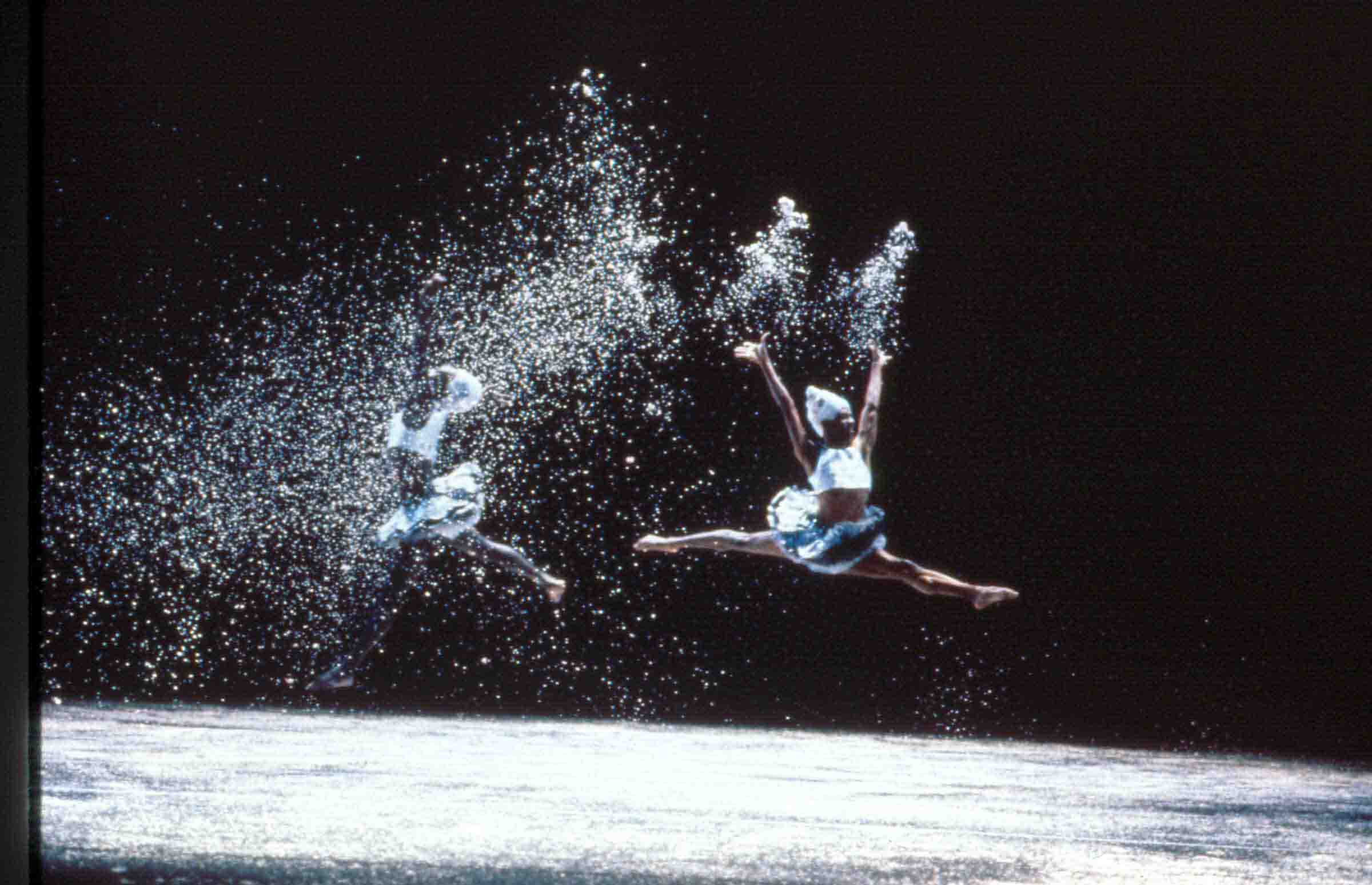
Stormy Weather: Members of the Mark Morris Dance Group
Photo: Catherine Ashmore
Each snowflake enters with fistfuls of white confetti, which she/he flings into the air, causing a mini-blizzard. Later, as the storm subsides into an eerie calm, the dancers travel horizontally, taking minuscule steps on tiptoe, arms outstretched to either side, dribbling "snow" from their fingers.
Visually magical, this representation of a snowstorm is playful, too, in its imaginative ingenuity. It's exactly what you might have arranged as a child, co-opting your neighborhood buddies to put on a Winter Wonderland show. What's more, activating your sense memory, it makes you recall the snowstorms that urged the kid you once were to run outdoors, exulting, as flakes got caught in your eyelashes or fell onto your extended tongue, melting just as you felt a small icy sting.
Naturally the steps Morris uses here belong to classical ballet's whirling and leaping families (as contrasted with his shuffling, earthbound work for the Flowers of Act II, perhaps because flowers are, after all, bound to the earth). The intricate geometrical patterns Snow calls for are deftly handled and always satisfying, at once stimulating the eye with their intricacy and soothing the spirit with their orderliness. They take their place in the ever more complex chain forged by Ivanov and Petipa, Balanchine, and now Morris and Alexei Ratmansky.
At this point, it should be noted that Morris delights in pedestrian action as well as artificially wrought beauty. The Snow scene ends the first of the ballet's two acts. During the intermission at BAM, the lush red stage curtain is raised about two feet so that the audience can watch the angular thrust of black-trousered lower legs coupled with the working end of brooms, as the stagehands sweep up the precious pale confetti for use in the next performance.
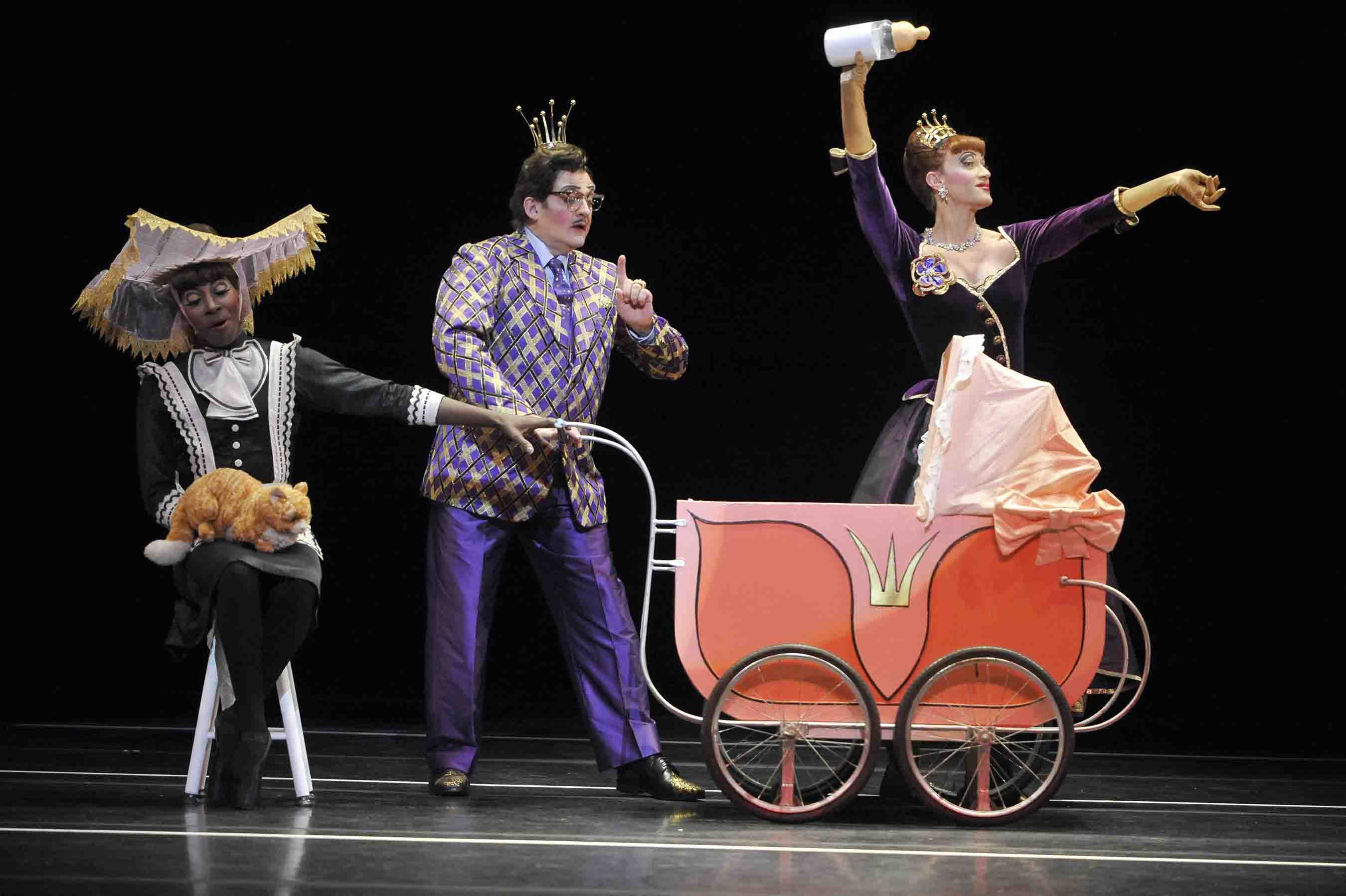
Don't I Know You From Somewhere? Maid (Kraig Patterson), Dad (Mark Morris), and Mom (John Heginbotham) transformed in the Pirlipat episode
Photo: Stephanie Berger
Hoffmann tells it so perfectly--in a mood that's simultaneously horrific, sardonic, and suggestive--that I wouldn't think of trying to convey the Pirlipat story-within-a-story that launches Act II. Suffice it to say that Drosselmeier, on pain of death if he fails, is sent to find the hard nut (hence, Morris's title) that's essential to giving Marie and her Nutcracker Prince a happy ending. His search, taking him to one foreign clime after another, provides a logical excuse for the exotic divertissements in Act II.
Most important in this sequence of dances is, of course, the Waltz of the Flowers--a large-scale corps de ballet event that's a cousin to the Snow scene. While the Snowflakes were creatures of the air, the Flowers are heavy, bent over the earth that sustains them, rooted, as it were. Among them is a soloist, flashing in and out of the matrices they form. This role, usually for a figure called Dewdrop and requiring scintillating technique, is none other than Marie's mom (John Heginbotham, as you'll recall), yet again pretending to a glory far beyond her temperament and gifts. Morris's empathy for the character and Heginbotham's subtle, layered portrayal combine to make your heart bleed even as you're laughing at the lady's absurdity.
The grand finale of The Hard Nut is an example of Morris's devotion to community, which he regularly gives an importance equal to that of individuals. Here the young lovers, rejoicing in a happy fate after grave trials, is introduced and supported--indeed, animated--by everyone who has taken part in the story. Represented are family, friends of same, maid, anonymous flowers and snowflakes, dresser and furniture mover, even a delicate mouse princess from the Pirlipat section. They are all there, Morris has said in an interview, because "they helped."
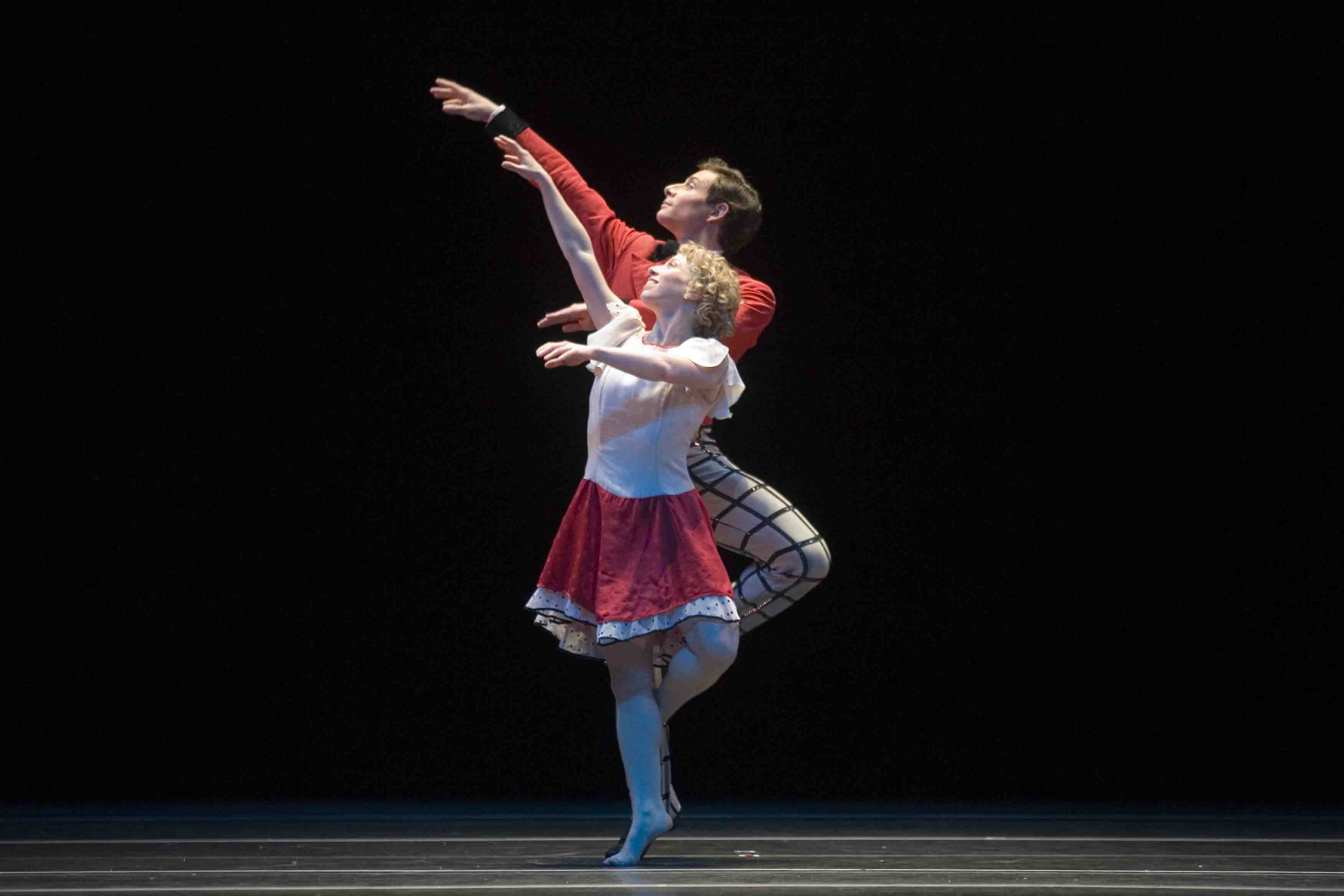
Happily Ever After? David Leventhal and Lauren Grant
Photo: Peter DaSilva
When the couple finally dances alone, their steps reveal them gradually losing their shyness when faced with real intimacy, and soon they kiss, and kiss again, and again. Even better yet, the two whisper into each other's ear, telling secrets. Well with whom else would you wish to exchange secrets, if not your best friend? And who more worthy to be your companion as you walk away into a presumably blessed future? You may need a stalwart mate because, since you've turned your back to the audience, you don't notice the mechanical rat with blazing red eyes that is scooting along behind you.
The Hard Nut ends its eight-performance run at BAM's Howard Gilman Opera House on December 19. It will be followed by Alexei Ratmansky's new version of The Nutcracker, for American Ballet Theatre, December 22 - January 2. Meanwhile, the National Ballet of Canada, which dances its own sumptuous Nutcracker in Toronto, is offering a tempting recipe for sugarplums.
© 2010 Tobi Tobias
Even after my daughter, a School of American Ballet student, outgrew (literally--the costumes have to fit) a string of kiddie roles in Balanchine's Nutcracker--Angel, Soldier, Polichinelle, Candy Cane--I still made many a trip to Lincoln Center for New York City Ballet's annual offering of the holiday production. As a dance critic, I've found the ballet infinitely engaging and worth considering from myriad angles. This season I've gone twice, both times to focus on the company dancer who fascinates me most these days: Sara Mearns, who is appearing in two roles--Dewdrop and the Sugarplum Fairy.
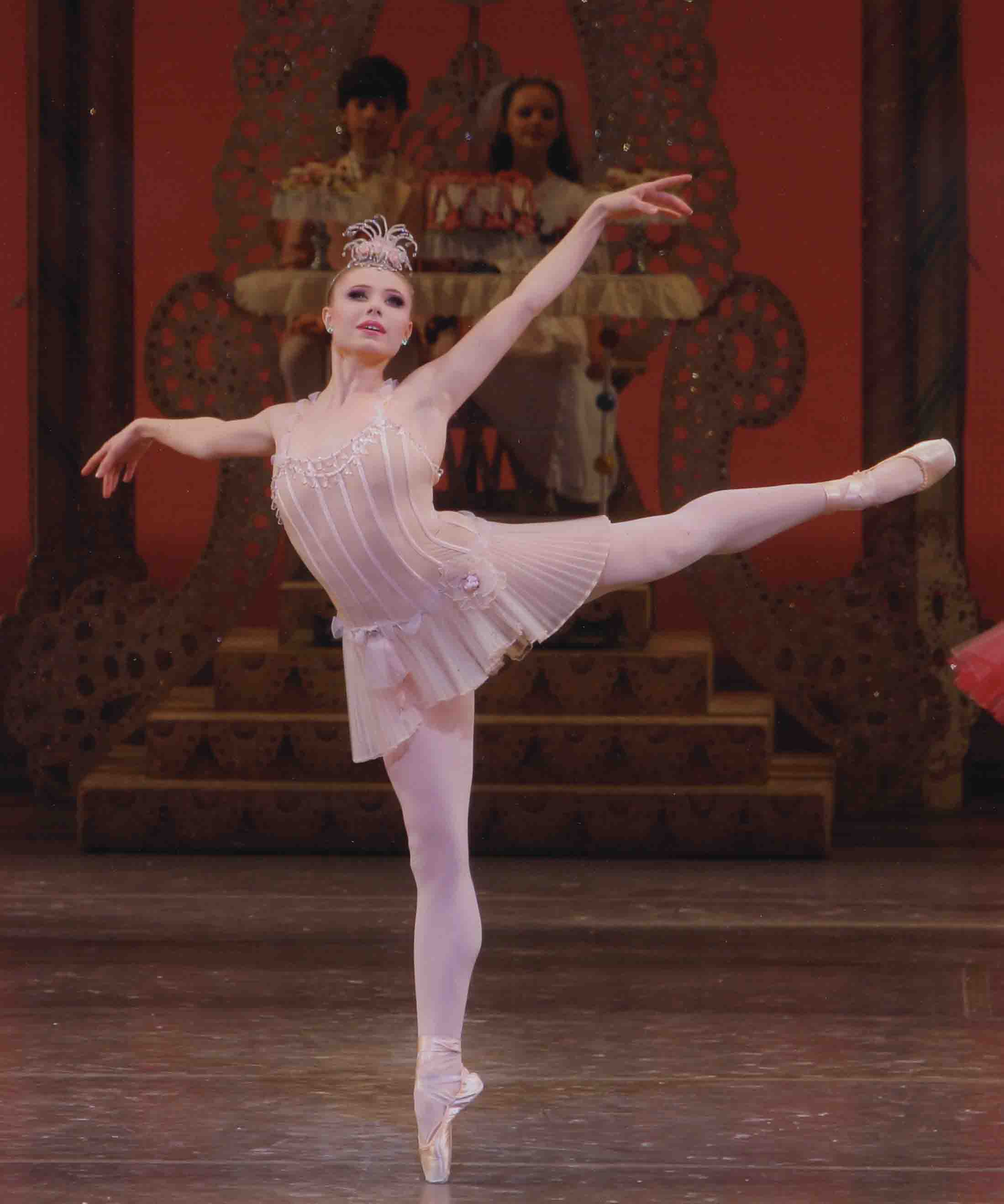
Enchanting the Children: New York City Ballet's Sara Mearns as Dewdrop, in George Balanchine's The Nutcracker
Photo: Paul Kolnik
The two characters are distinctly different in kind. The Sugarplum Fairy has been played most touchingly by Balanchine's ballerinas as tender, even motherly, to her "children." When we see her first, at the beginning of Act II, she marshals a bevy of diminutive Angels (the youngest and most petite of SAB's little girls), grave and often visibly nervous as they stream diagonally across the stage in intersecting lines, their tiny feet invisible underneath their gleaming white hoop skirts, their progress as smooth as poured cream. Soon afterward she's a child-sensitive host to the young Nutcracker Prince and the friend of his heart, Marie--a pair of courageous and exquisitely mannered children whom she has the grace to treat as if they were grown-ups.
Dewdrop is not really human at all, but abstract, or perhaps metaphoric. Brilliant as a faceted diamond, she tears through space and her network of Flowers--a virtuosa amidst the flurry of pink petals suggested by the corps women's costumes. The greatest Dewdrops I've seen were Heather Watts and Karin von Aroldingen, because somehow--only Terpsichore knows how--they gave the role a streak of the tragic. Their interpretation implied that a dewdrop, its shimmering life limited to a mere hour or two, was very much like dancing: dazzling, evocative, wondrous to be sure, but utterly ephemeral.
Mearns's Dewdrop was probably less rich and less relaxed than it promises to be a few years from now; she still has the air of a stranger to the role or, more accurately, an explorer or an investigator of it. Nevertheless it made me notice an aspect of her dancing I'd so far ignored.
Justly beloved by audiences at large, Mearns is the opposite of the so-called "Balanchine type": elongated, super-slender, and precise, every step hitting its mark. Mearns is generously proportioned, like Titian's luxurious nudes, and she extends her body into space with a matching generosity, even though doing so regularly challenges the vertical posture so important to ballet. As Dewdrop, she did all this with her upper body, and produced her familiar sensuous results, not once, it should be noted, allowing her natural amplitude to distort the music's timing. Her City Ballet predecessors in this kind of dancing have been rare, though memorable--Jillana, Stephanie Saland, and Balanchine's most potent muse, Suzanne Farrell.
Meanwhile, Mearns's legs and feet were telling a very different story. Her turns and swift footwork were airy, light, sharp--and plumb-line vertical. She was able to produce this quality at high pressure too. As her dance amidst her attendant Flowers progressed, she sped along the path they repeatedly opened to her with growing authority, excitement, and daring. The contrast between the two modes--lush and crystalline--was a show in itself. Born a natural dancer, Mearns has become a thinking one as well. This bodes well for her future.
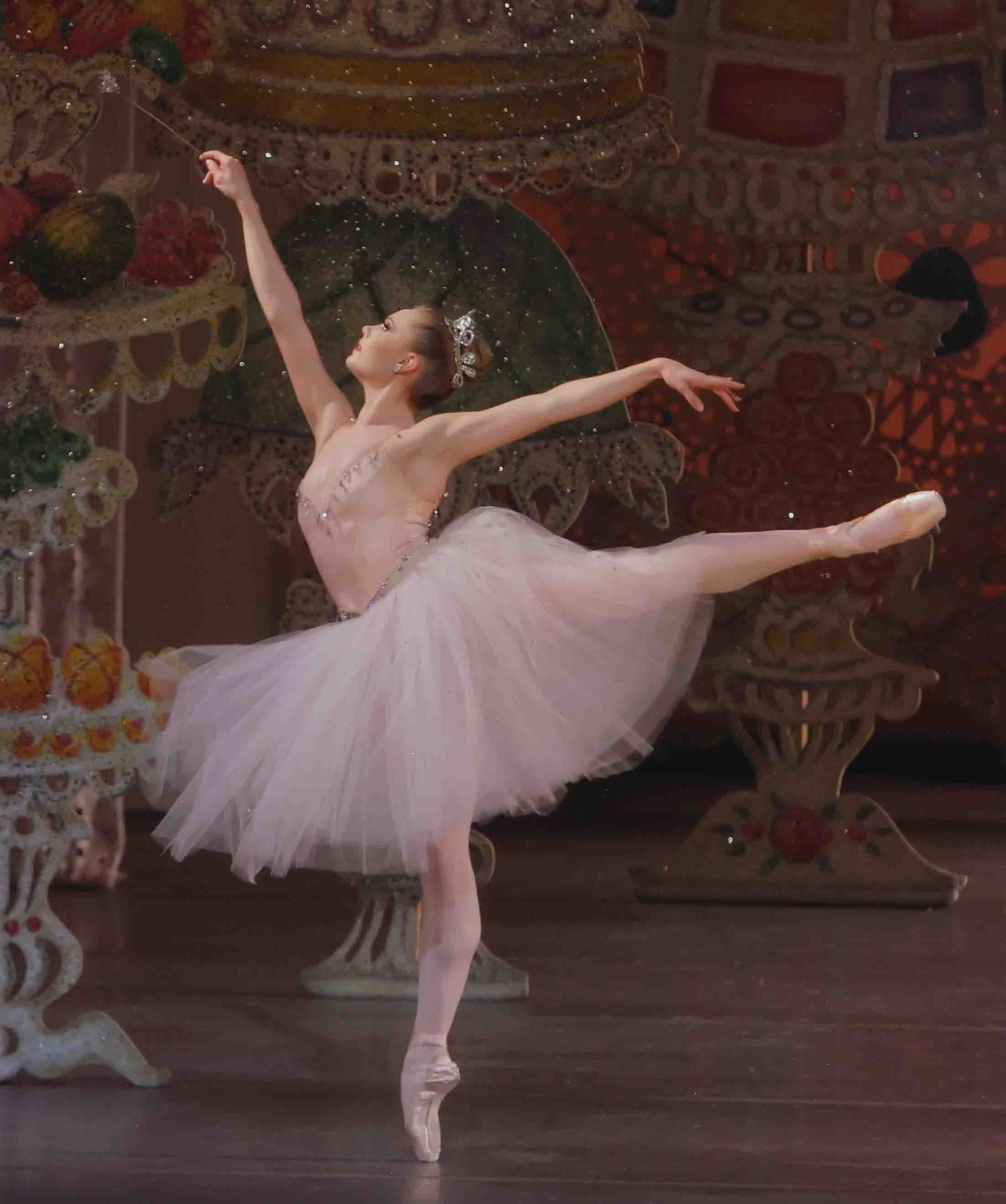
Wand in Hand: Mearns as the Sugarplum Fairy
Photo: Paul Kolnik
In her solo, to the otherworldly music of the celesta, Mearns traced the filigreed patterns of the choreography with delicate footwork, letting that ethereal quality permeate her body until she seemed to be made entirely of spun sugar.
Next she introduced the groups who would perform the divertissement dances--not as if they were subordinates or, worse, slaves trotted out to provide "entertainment," but as beloved and distinct social enclaves within her realm. Several of the groups represent a foreign, often exotic, clime: China (Tea), for example, Arabia (Coffee), Spain (sweetened chocolate). Obviously Sugarplum is pro-active when it comes to immigration.
When the little Prince arrived with Marie, Mearns's Sugarplum reacted with surprise, wonder, and concern as the boy related--in a mimed monologue Balanchine performed as a Maryinsky pupil in Russia--the sequence of events that led the youngsters to the "Land of Sweets." When the account was complete, Mearns sighed with relief and rejoicing, sweeping her arms upward and drawing a long breath that filled her torso.
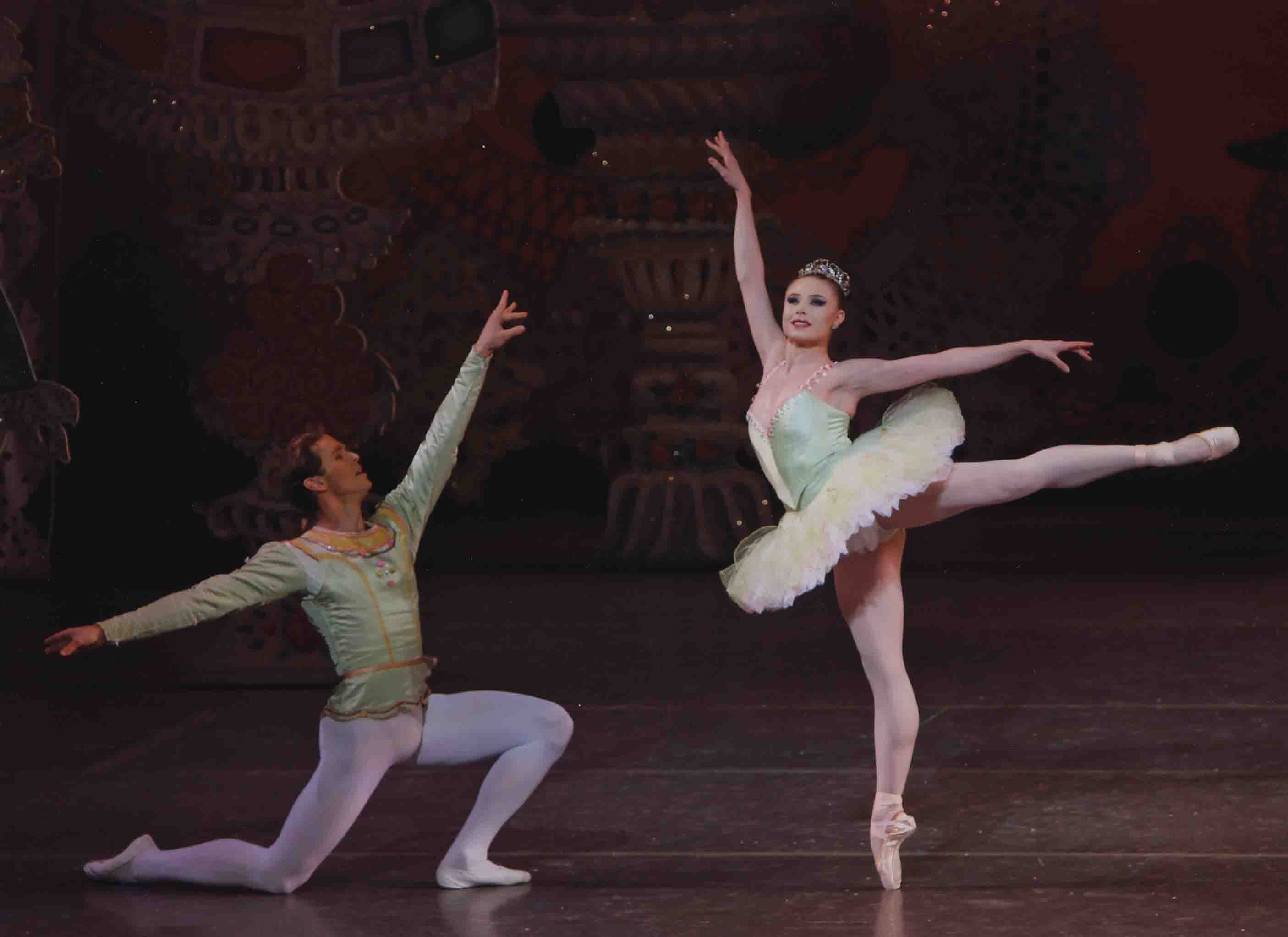
Cavalier in Attendance: Mearns as the Sugarplum Fairy, with Charles Askegard
Photo: Paul Kolnik
Cut to the grand pas de deux, where Mearns looked as if she were dancing in a cloud of her own perfume, letting her Cavalier be anonymous as, of course, Balanchine designed him to be. He's there simply to support the woman--in balances, in multiple pirouettes, into the air--so that she can display the full range of her allure. Remember, Balanchine's the choreographer who declared "ballet is woman" and frequently said that his function as a choreographer was to serve her.
Mearns made everything in this duet soft, secure, easy--as if were occurring in the dream of a woman focusing on the sensations of her own being. Towards the finish line of this remarkable variation on the theme of lovers' meeting, Mearns circled the stage in a wide chain of turns until she called to mind a race car speeding up to a wild and dangerous--potentially fatal--pace. This was typical of Mearns's raw, caution-to-the-winds magnificence, which was one of the first things we knew about her. Now we know more.
The New York City Ballet will be performing George Balanchine's The Nutcracker at the David H. Koch Theater, Lincoln Center, NYC, through January 2, 2011.
© 2010 Tobi Tobias
Black Swan / Opened December 3, 2010
Surely The Red Shoes, created by Michael Powell and Emeric Pressburger, is the most beloved ballet film of all time. My innocent eyes and heart were ravished by it shortly after its premiere in 1948. Shot in fabulous color--it glowed like a handful of precious jewels--the movie was built on a melodramatic exaggeration of a myth still popular at the time. The idea (which had a modicum of truth in it), was that being a ballerina was a full-time job and a half, leaving no room whatsoever for love or its frequent partner, domesticity. Woe betide the gifted young dancer, then, who found herself caught in the conflict between artistic glory and romantic satisfaction.
I'll never forget the final shot of the movie's anguished heroine, Moira Shearer--a great beauty of a ballerina, her porcelain skin and aquiline profile framed in a cloud of delicately curling red hair--just after she'd flung herself into the path of a moving train. I can still see her svelte stilled legs in their pale ballet tights and the gleaming red pointe shoes--all bloodied.
Some two decades later, as if performing a ritual, I took my nine-year-old daughter and two of her schoolmates to the film and, in the fullness of time, one of my daughter's daughters, at the same age. Similarly seduced mothers had been doing so since The Red Shoes first opened, and, if it fired the imaginations of their fledgling daughters, as it reliably did, enrolled the girls in ballet school. (Not until Billy Elliot did boy aspirants get an equal opportunity.)
Times have changed. The ostensible ballet movie of the moment is Darren Aronofsky's extravagantly promoted Black Swan which, a week before its December 3 opening, had finally gotten around to describing itself, accurately, as "a psycho-sexual thriller." Eerily, it has a lot in common with The Red Shoes. It's pitch perfect in embodying passé Romantic myths about (1) classical ballet, (2) madness, and (3) sex (formerly known as love). Nevertheless, mothers with any sense in them will lock up their daughters rather than regale them with this show.
Here's the "official trailer"--a don't-miss--of Black Swan:
The tale this flick tells: Nina (Natalie Portman, with the help of choreographer Benjamin Millepied; intensive re-training in classical dance which she studied in an earlier life; and a double, American Ballet Theatre's Sarah Lane, for the tricky bits) is a lovely young dancer--all radiant innocence and vulnerability--on her way to stardom in a world-class ballet company based in New York. She comes equipped with a few problems, though.
Problem 1: The company's director (Vincent Cassel), obsessively controlling (like the Red Shoes's Lermontov) and erotically rapacious, is mounting a new production of Swan Lake. Nina's a natural for half of the dual leading role that would be her break-through--the pure, lyrical Odette, queen of a bevy of swans who are actually maidens entrapped by an evil sorcerer. However she can't manage to embody the evil Odile (the black swan) who, impersonating Odette, seduces the prince who has vowed to rescue the pure object of his affections. "Your dancing is still frigid," "I never see you lose yourself," the director complains to his protégée--and of course suggests sex as the perfect cure-all.
Problem 2: Nina's mental health is shaky at best. So as the plot tangles, she's more and more subject to hallucinations, each of them so ambiguous at first that the viewer, as well as Nina, confuses them with actuality.
In real life, Nina has to deal with the cruelty of the young replacing the old, as is common--and inevitable--in the performing arts. The director gives Nina the lead in Lake (as insiders call it) and publicly fires the company's aging prima, who attempts suicide. Then, as Nina becomes increasingly unhinged by the strain of making good in the role, she finds herself threatened by Lily (Mila Kunis), a hardier and earthier type than our ingénue, whom the director imports--from California, where else?--to take over as Odette-Odile if necessary.
Lily's resulting gaudy nightmares about her situation involve (semi-graphic) masturbation, group sex, and lesbian sex, with the assumption that they're still no-nos. And murder (Nina offs Lily), which is still generally frowned upon. (The huge New York audience for the preview I attended found much to laugh at.) After imagining a fucking session with Lily--talk about sleeping with the enemy!--Nina tells her rival about it as if it had actually happened. "Was I good?" Lily asks. This is the only intentionally funny line in the show.
If matters weren't gothic enough without it, blood is a key element in Black Swan. Early in the film Nina develops a rash on her back that she scratches until it bleeds, introducing the theme of self-harm, specifically cutting, a behavior observed in people with "issues." Nina takes the sanguine vein all the way. Soon she's oozing blood from her fingertips. Finally she inserts a mean knife into her vagina and--after a triumphant debut in Lake--expires with blood soaking through her white, thickly feathered tutu between her breasts and at her belly. "I was perfect," she whispers of her performance as she lies dying, "I was perfect." So much for amateur psychology mated with cheap thrills. And an inordinate desire to cop an Oscar.
It's probably overkill, or too late, but I should mention Nina's Problem 3. Though surely old enough for her own digs, she lives with her mom. Who is a ballet mom, over-protecting, indeed smothering, the daughter for whom she's sacrificed her own dancing career. I wouldn't even bother mentioning this--the caricature is without compassion and old hat besides--except for the fact that Barbara Hershey, who plays the role, is by far the most accomplished actor in the film. Her portrayal of the self-sacrificing yet fatally needy woman is honest, deep, and extremely subtle. You can almost believe that this momma took her kid to see The Red Shoes with the best intentions in the world.
For the sake of completeness, see the trailer for The Red Shoes:
© 2010 Tobi Tobias
Sitelines
AJ Ads
 360° Dance Company at DTW offers two socially relevant revivals, Jane Dudley’s solo “Time Is Money” (1932) and Mary Anthony’s “Devil in Massachusetts” (1952) as well as the World Premier of Artistic Director, Martin Lofsnes' "6-1".
360° Dance Company at DTW offers two socially relevant revivals, Jane Dudley’s solo “Time Is Money” (1932) and Mary Anthony’s “Devil in Massachusetts” (1952) as well as the World Premier of Artistic Director, Martin Lofsnes' "6-1".
AJ Blogs
AJBlogCentral | rssculture
Terry Teachout on the arts in New York City
Andrew Taylor on the business of arts & culture
rock culture approximately
Laura Collins-Hughes on arts, culture and coverage
Richard Kessler on arts education
Douglas McLennan's blog
Dalouge Smith advocates for the Arts
Art from the American Outback
Chloe Veltman on how culture will save the world
For immediate release: the arts are marketable
No genre is the new genre
David Jays on theatre and dance
Paul Levy measures the Angles
Judith H. Dobrzynski on Culture
John Rockwell on the arts
innovations and impediments in not-for-profit arts
Jan Herman - arts, media & culture with 'tude
dance
Apollinaire Scherr talks about dance
Tobi Tobias on dance et al...
jazz
Howard Mandel's freelance Urban Improvisation
Focus on New Orleans. Jazz and Other Sounds
Doug Ramsey on Jazz and other matters...
media
Jeff Weinstein's Cultural Mixology
Martha Bayles on Film...
classical music
Fresh ideas on building arts communities
Greg Sandow performs a book-in-progress
Harvey Sachs on music, and various digressions
Bruce Brubaker on all things Piano
Kyle Gann on music after the fact
Greg Sandow on the future of Classical Music
Norman Lebrecht on Shifting Sound Worlds
Joe Horowitz on music
publishing
Jerome Weeks on Books
Scott McLemee on books, ideas & trash-culture ephemera
theatre
Wendy Rosenfield: covering drama, onstage and off
visual
Public Art, Public Space
Regina Hackett takes her Art To Go
John Perreault's art diary
Lee Rosenbaum's Cultural Commentary
